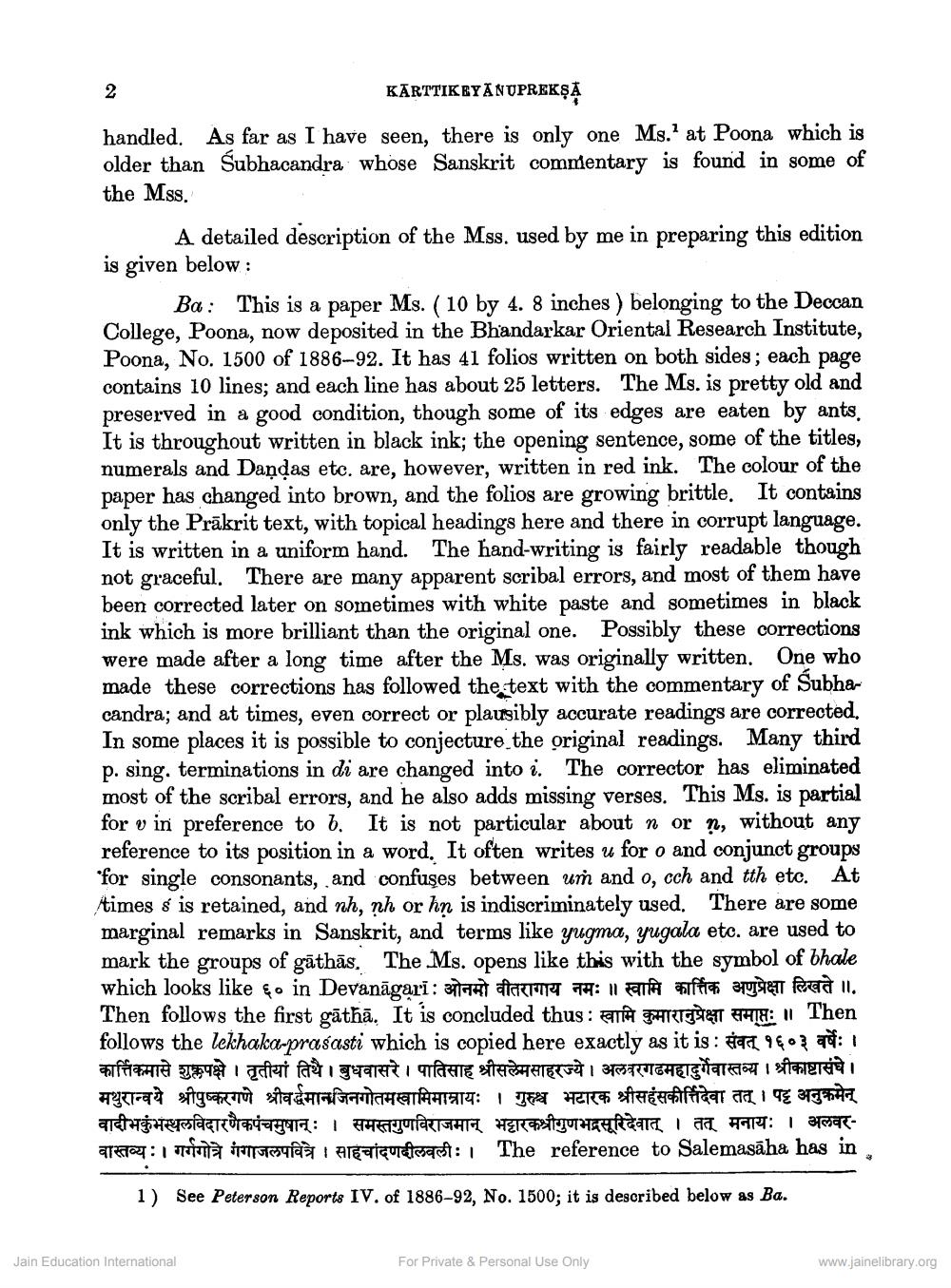________________
KĀRTTIKEYANUPREKŞA
handled. As far as I have seen, there is only one Ms. at Poona which is older than Subhacandra whose Sanskrit commentary is found in some of the Mss.
A detailed description of the Mss. used by me in preparing this edition is given below:
Ba: This is a paper Ms. (10 by 4. 8 inches ) belonging to the Deccan College, Poona, now deposited in the Bhandarkar Oriental Research Institute, Poona, No. 1500 of 1886-92. It has 41 folios written on both sides; each page contains 10 lines; and each line has about 25 letters. The Ms. is pretty old and preserved in a good condition, though some of its edges are eaten by ants. It is throughout written in black ink; the opening sentence, some of the titles, numerals and Daņdas etc. are, however, written in red ink. The colour of the paper has changed into brown, and the folios are growing brittle. It contains only the Prākrit text, with topical headings here and there in corrupt language. It is written in a uniform hand. The hand-writing is fairly readable though not graceful. There are many apparent scribal errors, and most of them have been corrected later on sometimes with white paste and sometimes in black ink which is more brilliant than the original one. Possibly these corrections were made after a long time after the Ms. was originally written. One who made these corrections has followed the text with the commentary of Subhacandra; and at times, even correct or plausibly accurate readings are corrected, In some places it is possible to conjecture the original readings. Many third p. sing. terminations in di are changed into i. The corrector has eliminated most of the scribal errors, and he also adds missing verses. This Ms. is partial for v in preference to b. It is not particular about n orn, without any reference to its position in a word. It often writes w for o and conjunct groups *for single consonants, and confuses between uṁ and o, cch and tth etc. At Aimes s is retained, and nh, nh or hn is indiscriminately used. There are some marginal remarks in Sanskrit, and terms like yugma, yugala etc. are used to mark the groups of gāthās. The.Ms. opens like this with the symbol of bhale which looks like ço in Devanāgari: 3707 Stagii : Il a affia suge ferata II. Then follows the first gātħā. It is concluded thus : CI HARTGET HAH: | Then follows the lekhaka-prasasti which is copied here exactly as it is : HTTL 9603 at: 1 कार्तिकमासे शुक्लपक्षे । तृतीयां तिथै। बुधवासरे। पातिसाह श्रीसलेमसाहरज्ये। अलवरगढमहादुर्गेवास्तव्य । श्रीकाष्टासंघे। मथुरान्वये श्रीपुष्करगणे श्रीवर्द्धमानजिनगोतमखामिमाम्रायः । गुरुश्च भटारक श्रीसहंसकीर्तिदेवा तत् । पट्ट अनुक्रमेन् वादीभकुंभस्थलविदारणैकपंचमुषान् : । समस्तगुणविराजमान् भट्टारकश्रीगुणभद्रसूरिदेवात् । तत् मनायः । अलवरarray:1 Totalà i I Agatcuesact: The reference to Salemasāha has in
1)
See Peterson Reports IV. of 1886-92, No. 1500; it is described below as Ba.
Jain Education International
For Private & Personal Use Only
www.jainelibrary.org




